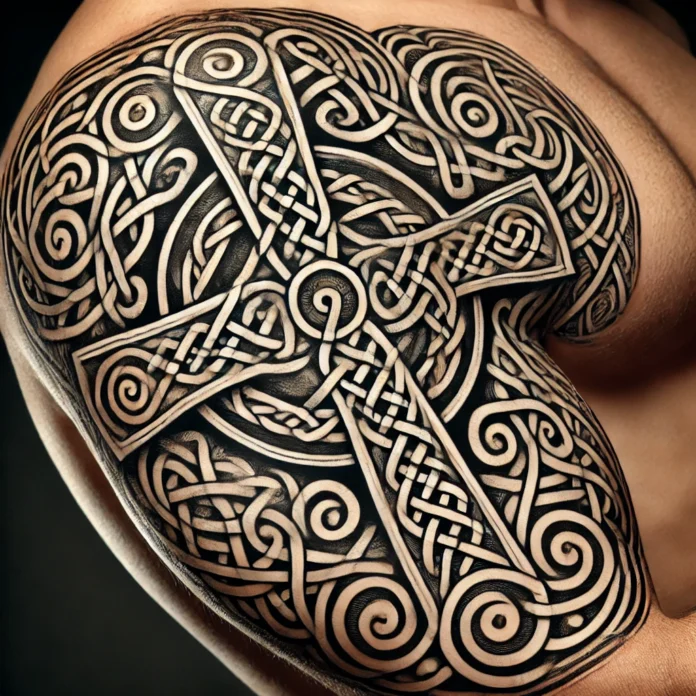Celtic tattoos have a deep-rooted history that dates back centuries, symbolizing strength, heritage, and spirituality. These intricate designs, known for their mesmerizing patterns and endless knots, have grown increasingly popular in modern tattoo culture. However, while Celtic tattoos hold immense artistic and cultural significance, they come with unique challenges that should not be overlooked.
This article explores the intricacies of Celtic tattoo designs, the difficulties in getting them inked, and essential tips to ensure a flawless outcome.
Read More: DEEPER SYMBOLISMS OF POLYNESIAN TATTOOS
Understanding Celtic Tattoo Designs
Celtic tattoos are characterized by elaborate patterns that often lack a clear beginning or end, symbolizing eternity and interconnectedness. Some of the most common Celtic tattoo motifs include:
1. Celtic Knots
These endless loops represent eternal life, love, and unity. Their intricate weaving makes them one of the most recognizable Celtic symbols in tattoo art.
2. Celtic Cross
A fusion of Christian and pagan traditions, the Celtic cross symbolizes faith, spirituality, and the four elements of nature.
3. Animals and Mythical Creatures
Celtic warriors often adorned their bodies with animal-inspired tattoos, believing that each creature carried specific powers. For instance, the Celtic wolf symbolizes protection, while the dragon represents wisdom and strength.
4. Triskelion (Triple Spiral)
This ancient Celtic symbol signifies progress, personal growth, and the balance of mind, body, and spirit.
While these designs are rich in meaning, they require exceptional precision to execute correctly, leading to various challenges.
Challenges of Getting a Celtic Tattoo
1. Complexity of the Design
One of the biggest difficulties with Celtic tattoos is their intricate detail. The interwoven lines and symmetrical patterns require a steady hand and precise execution. Even the slightest mistake can disrupt the overall design, making it look unbalanced or distorted.
2. Finding the Right Tattoo Artist
Not every tattoo artist is well-versed in Celtic patterns. Since these tattoos rely heavily on precision and symmetry, it is crucial to choose an artist with experience in detailed linework. A lack of expertise can lead to gaps, breaks, or misaligned knots, which can ruin the aesthetic appeal.
3. Placement Considerations
Celtic tattoos often consist of delicate linework that must flow seamlessly with the body’s contours. Certain body areas, such as the ribs or hands, may cause the design to stretch or warp over time. Ideal placement areas for maintaining clarity include the upper arm, back, or calf.
4. Pain and Healing Process
Due to the fine lines and shading involved in Celtic tattoos, the process can be more painful compared to simpler designs. Areas with thinner skin, such as the wrists and ribs, tend to be more sensitive. Proper aftercare, including moisturizing and protecting the tattoo from excessive sun exposure, is essential to prevent fading and distortion.
Mistakes to Avoid with Celtic Tattoos
1. Choosing an Inexperienced Artist
Since Celtic tattoos require precision, selecting an artist without a proven track record in intricate designs can lead to disappointing results. Always review an artist’s portfolio before making a decision.
2. Incorrect or Culturally Inappropriate Designs
Not all patterns labeled as “Celtic” are historically accurate. Some modern interpretations may stray from authentic Celtic symbolism. It is advisable to research traditional designs or consult with a knowledgeable tattoo artist to ensure authenticity.
3. Overly Complex Designs in Small Areas
Attempting to fit an elaborate Celtic design into a small space can compromise the detail and readability of the tattoo. If opting for a smaller tattoo, consider simplifying the pattern to maintain clarity and longevity.
Conclusion
Celtic tattoos are more than just body art; they represent deep cultural heritage and timeless beauty. However, their intricate nature poses significant challenges, from finding a skilled artist to ensuring proper placement and care.
By thoroughly researching the design, choosing an experienced tattoo artist, and understanding the potential challenges, individuals can achieve a stunning Celtic tattoo that stands the test of time. Proper planning and commitment will ensure that this meaningful art form remains a proud symbol of strength, unity, and tradition for years to come.
FAQs
Can anyone get a Celtic tattoo?
Yes, anyone can get a Celtic tattoo, but it’s important to respect its cultural significance and choose an authentic design.
What is the most powerful Celtic symbol tattoo?
The Celtic knot is one of the most powerful symbols, representing eternity, unity, and interconnectedness.
Are Celtic tattoos Irish or Scottish?
Celtic tattoos originate from both Irish and Scottish traditions, as both cultures share Celtic heritage and symbolism.
What is the difference between Norse and Celtic tattoos?
Norse tattoos often depict mythology, runes, and Viking symbols, while Celtic tattoos focus on intricate knots, spirals, and ancient Gaelic symbolism.
